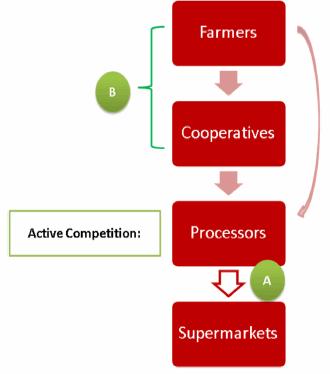



The Milk Supply Chain Project
By Howard Smith and John Thanassoulis, Department of Economics, University of Oxford. This report presents the results of an Oxford University research project into the UK liquid milk supply chain. Financial sponsorship was kindly provided by the Milk Development Council (MDC) and by DEFRA. A link to the full report is provided at the bottom of the page.The project's aim is to investigate the competitive forces which influence the buyerseller relationships between supermarkets, processors and farmers; to measure and understand the level of market power that exists at each stage in the supply chain; and to understand the effects of this market power on the main players in the supply chain.
Layman's Introduction
Overview
This introduction gives a layman's overview of the findings of the three research papers which were developed in the Dairy Supply Chain research project, undertaken at Oxford University with financial assistance from the Milk Development Council. The papers themselves follow in Chapters 1-3 respectively.
The project's aim is to investigate the competitive forces which influence the buyerseller relationships between supermarkets, processors and farmers; to measure and understand the level of market power that exists at each stage in the supply chain; and to understand the effects of this market power on the main players in the supply chain. The research methods include (i) interviews with industry executives at all stages in the supply chain; (ii) the theoretical modelling of price setting at all levels in the industry and (iii) the empirical estimation of the model using data provided by the Milk Development Council.
Chapter 1 Estimating Bargaining Power In The Supply Chain explores the relationship between supermarkets, processors, and suppliers. A theoretical model is presented, based on assumptions that come from the interviews undertaken in the project.
In the model of processor-supermarket bargaining the processors are in competition to supply milk to supermarkets who are themselves in competition. The competition between processors creates uncertainty for any individual processor as to its final output. The negotiated price lies naturally between an upper and a lower bound. The upper bound is the price that the supermarket could obtain by going abroad for its milk; the lower bound is the marginal production cost of the milk.
The exact point between these bounds that the two sides will negotiate depends on the number of processors and the bargaining power of the supermarkets. The more processors there are the more options the supermarkets have and lower the price the processors negotiate. We fit this model of bargaining to data on prices and costs from the milk industry.
A model of negotiation between farmer cooperatives and processors is also developed. Following discussions with the industry we consider this best modelled using a bilateral monopoly in which cooperatives and processors split the gains from trade according to their bargaining power. The farmers are assumed to have an inside option given by the commodity market prices that are available. (This captures the cost and opportunity cost to the farmers of supplying milk for drinking). We use price data to estimate the bargaining power of the processors in the processor-cooperative negotiations. The prices obtained by direct farmers are determined as a mark-up to the prices obtained by the farmer cooperatives.
Overall the model explains: (i) the prices negotiated between processors and supermarkets; and (ii) the prices obtained by coops and direct farmers. The model provides a method for calculating how profit splits would alter if parties were to merge or if costs were to change. We explore some of these counterfactuals.
Chapter 2 Milk Prices in Retail Competition explores retail pricing behaviour by supermarkets. Unlike previous studies of milk demand we are able to estimate elasticites of demand for milk at the level of the retailer rather than at the level of the product. This allows us to analyze the pricing incentives of supermarkets. We develop a model of consumer choice in which consumers choose their supermarket based on the retail prices of a basket of products. Milk is an important component of most shoppers' baskets. Supermarkets are assumed to set their retail prices to maximize profits over marginal costs. Alternative models of supermarket pricing include cooperative and noncooperative pricing. The retail mark-up that is obtained depends on (i) the price sensitivity of consumers and (ii) whether or not supermarkets cooperate with each other in their setting of milk prices. To estimate the model we use consumer data from the TNS survey as provided by the MDC. We find that the estimated price elasticites of consumers imply non-cooperative mark-ups that are close to the actual mark-ups. Thus, the model suggests that the market power enjoyed by supermarkets (i.e. their ability to increase prices above marginal cost) derives from the price sensitivity of consumers rather than from any attempt by supermarkets to coordinate prices.
Chapter 3 Upstream Competition and Downstream Buyer Power This paper extends the theory model in Chapter 3 to explore the circumstances in which (i) a large supermarket buyer has more buyer power than small supermarkets (ii) the presence of a large buyer causes prices negotiated by small buyers to increase (a phenomenon known as a waterbed effect). As in Chapter 1 competition between processors creates uncertainty for any individual processor as to its final output; i.e. the model incorporates the uncertainty experienced by a supplier at the point of negotiation with any given buyer over how successful the supplier it will be with the other buyers. In this setting we find a new source of buyer power when supplier cost functions are nonlinear: the event of negotiation with a large buyer increases the seller.s expected output, which changes the expected average costs of supplying the buyer. This increases the power of a large buyer when the seller.s cost function has increasing returns to scale. We use this framework to analyze the pricing and welfare consequences of changes to market structure upstream and downstream. We also analyze investment consequences of buyer power. We show that upstream suppliers respond to buyer power by selecting technologies with increasing returns to scale, which disadvantage smaller buyers and benefit larger buyers.
 |
|
The Milk Supply Chain
|
Further Reading
| - | You can view the full report by clicking here. |
January 2008



